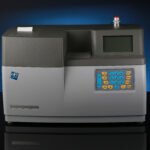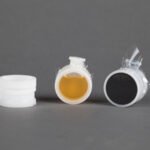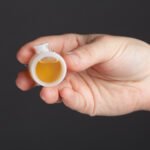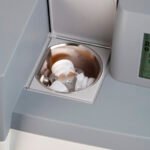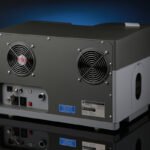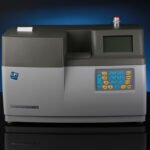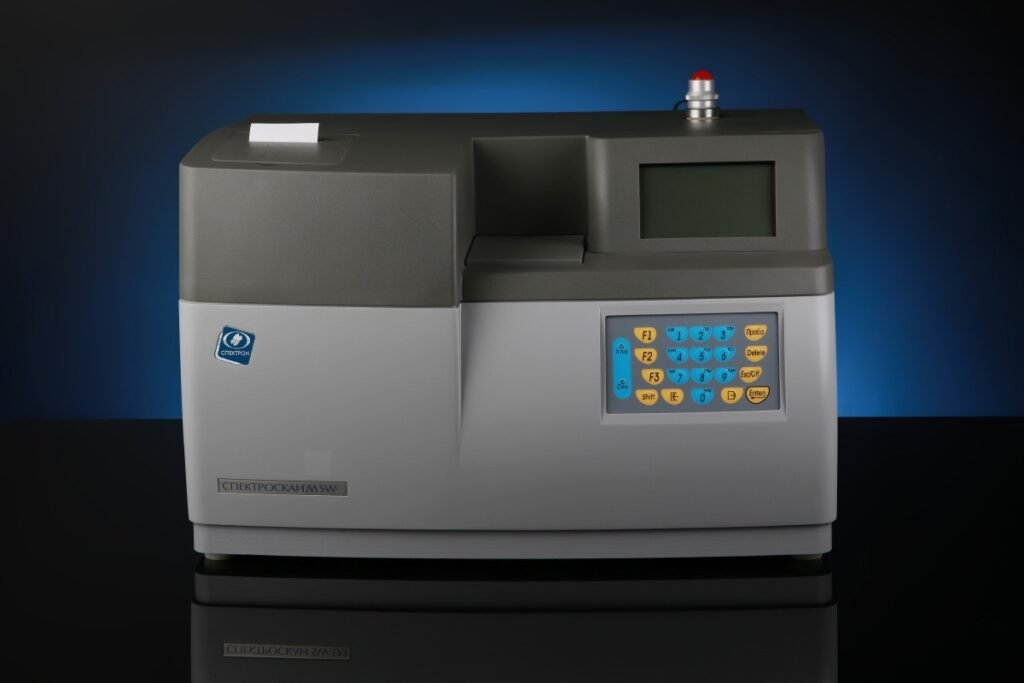Wave dispersive x-ray fluorescence analyzer
SPECTROSCAN SW-D3 Wave-dispersive x-ray fluorescence analyzer
The wave-dispersive x-ray fluorescence sulfur analyzer is designed to measure the mass fraction of sulfur in automotive fuel, as well as in oil and petroleum products.
Wave dispersive x-ray fluorescence analyzer (Spectroscan SW-D3)
Implements an arbitration method for measuring the mass fraction of sulfur in automobile fuels of the third, fourth and fifth classes.
The device is designed specifically for high-quality and fast X-ray fluorescence analysis of fuel in accordance with the technical regulation “On the requirements for automobile and aviation gasoline, diesel and marine fuel, jet fuel and heating oil”, which establishes an arbitration X-ray fluorescent wave dispersive method for determining the mass fraction of sulfur in automobile fuels of fourth and fifth grades.
The wavelength-dispersive sulfur analyzer SPECTROSKAN SW-D3 is designed to meet all the requirements for the process of X-ray fluorescence elemental analysis of low sulfur content in petroleum products. Operator actions during measurements are minimized:
– enter the sample number / name from the built-in keyboard;
– the sample is poured into two cuvettes;
– the obtained samples are placed in the analyzer and measurements are started.
The analyzer performs all subsequent actions automatically without operator participation:
– calculates and displays the sulfur content in the sample;
– calculates the convergence – the difference in determining the mass fraction of sulfur in the first and second samples;
– prints the measurement results on the built-in printer.
Characteristics of Wave dispersive X-ray fluorescence analyzer (Spectroscan SW-D3)
The analyzer is a benchtop device controlled by an embedded microprocessor computer. Structurally, the analyzer consists of two units: a spectrometric unit and a vacuum pump unit. The spectrometric unit includes a closed-type water cooling unit and a spectrometric path, which is evacuated using a vacuum pump. In this case, the analyzed samples remain in the air.
| Analytical parameters | |
| The element being defined | S (sulfur) |
| Sulfur mass fraction measurement range, mg / kg | from 2.0 to 50,000 |
| Limits of permissible absolute error, mg / kg | ± (0.04 X + 1.1) where X is the mass fraction of sulfur, mg / kg |
| Repeatability limit * of the results of single measurements (P = 0.95), mg / kg, in the measurement range, mg / kg: – from 2 to 60 inclusive sv. 60 to 500 inclusive St. 500 to 50,000 * modulus of the difference between two successive measurements of the mass fraction of sulfur in two samples of one sample. | 0.045 X + 0.3 4.0 0.017 X-4.5 where: X – mass fraction of sulfur, mg / kg |
| Detection limit in 300 s | 0.1 mg / kg |
| Sulfur mass fraction indication range | from 0 mg / kg to 5.0% |
| Sulfur line isolation method | crystal diffraction |
| X-ray optical scheme | according to Johann |
| Crystal analyzer | pyrolytic carbon C (002) |
| X-ray tube | with chrome anode |
| Measurement time of two parallel samples (1 sample) | from 8 minutes |
| Specifications | |
| Sample loader | lateral, for three samples (automatic), installation of samples – vertical |
| Cuvettes: diameter, volume | ∅32 mm, V 8 cm 3 , ventilated |
| X-ray tube power | 160 watts |
| Interface | built-in display and thermal printer, USB interface with PC |
| Overall dimensions and weight (no more) | 530х480х340 mm, 40 kg – spectrometric unit 330х230х380 mm, 15 kg – vacuum pump |
| Energy consumption | 220 V, ~ 50 Hz, 750 W |
Benefits of Wave dispersive X-ray fluorescence analyzer (Spectroscan SW-D3)
Thanks to the specially developed design of the analyzer and the applied technical and design solutions, the following advantages have been achieved:
– no need to purge the measuring path with helium;
– sulfur detection limit from 0.1 ppm;
– easy to use;
– desktop, does not take up much space;
– a three-position sample loading device allows simultaneously loading two parallel samples into the device;
– due to the lateral position of the sample:
– errors caused by the presence of water and air bubbles in oil products are excluded;
– contamination with oil products and internal components of the analyzer is excluded;
– the error associated with contamination of the additional protective film is excluded;
– the cuvette compartment is easy to clean;
– information about the sample and the analysis result are displayed on the display and printed out on the built-in printer;
– special ventilated cuvettes have been developed for the analyzer, allowing the analysis of volatile oil products.
The analyzer is designed specifically for determining the mass fraction of sulfur and allows you to solve the following tasks:
Determination of sulfur in oil and petroleum products according to GOST R 53203
Determination of sulfur by wavelength dispersive X-ray fluorescence spectrometry.
Determination of sulfur content by X-ray fluorescence spectrometry with wave dispersion.
Cooling liquid 500 ml
Pasteur
pipette Vented cuvette, diameter 32 mm (pack of 100 pcs)
Standard sample of the mass fraction of sulfur in mineral oil (0.0%,)
Standard sample of the mass fraction of sulfur in mineral oil (2 ppm)
Standard sample of the mass fraction of sulfur in mineral oil oil (5 ppm)
Standard mass fraction of sulfur in mineral oil (10 ppm)
Standard mass fraction of sulfur in mineral oil (25 ppm)
Standard mass fraction of sulfur in mineral oil (50 ppm)
Standard mass fraction of sulfur in mineral oil ( 100 ppm)
Standard mass fraction of sulfur in mineral oil (300 ppm)
Standard mass fraction of sulfur in mineral oil (600 ppm)
Standard mass fraction of sulfur in mineral oil (0.1%)
Standard mass fraction of sulfur in mineral oil (0.2%)
Standard mass fraction of sulfur in mineral oil (0 , 5%)
Standard mass fraction of sulfur in mineral oil (1.0%)
Standard mass fraction of sulfur in mineral oil (2.0%)
Standard mass fraction of sulfur in mineral oil (3.0%)
Standard mass fraction Sulfur in mineral oil (4.0%)
Standard mass fraction of sulfur in mineral oil (5.0%)
Thermal paper for printer
Standard mass fraction of sodium and chlorine in solid base (KO-107)
Entrance slot unit
Polyethylene terephthalate film 3.5 μm (roll 100 m)
Sample for adjusting KCl
Sample for adjusting KO-D3
SPECTROSCAN CLSW Wave-dispersive x-ray fluorescence analyzer
Wave-dispersive x-ray fluorescence analyzer for determination of the mass fraction of chlorine and sulfur in liquid samples.
Wave dispersive X-ray fluorescence analyzer (Spectroscan CLSW)
Implements arbitration methods for determining the mass fraction of organochlorine compounds in oil and sulfur content in automotive fuel.
The analyzer has successfully passed interlaboratory tests under the supervision of JSC VNII NP (TK31). As a result of the tests, the accuracy of the method for determining the mass fraction of organochlorine compounds using the SPEKTROSKAN CLSW analyzer was found to comply with the requirements of GOST R 52247-2004, method B, and the precision indicators of the method were determined in the range of the mass fraction of organochlorine compounds from 1 ppm to 50 ppm.
When determining the sulfur content, the analysis is carried out without additional sample preparation.
Operator actions during measurements are minimized:
– enter the number / name of the sample from the built-in keyboard;
– the sample is poured into two cuvettes;
– the obtained samples are placed in the analyzer and measurements are started.
The analyzer performs all subsequent actions automatically without operator participation:
– calculates and displays the chlorine and / or sulfur content in the sample;
– calculates convergence – the difference in determining the mass fraction of an element in the first and second samples;
– prints the measurement results on the built-in printer.
Characteristics of Wave dispersive X-ray fluorescence analyzer (Spectroscan CLSW)
The analyzer is a benchtop device controlled by an embedded microprocessor computer. Structurally, the analyzer consists of two units: a spectrometric unit and a vacuum pump unit.
| Analytical characteristics: | ||
| The element being defined | Cl (chlorine) | S (sulfur) |
| Detection limit | 0.07 mg / kg (ppm) for 600 s | 0.2 mg / kg (ppm) for 300 s |
| Range of indications of the mass fraction of chlorine and sulfur (variable) | from 0.07 mg / kg to 1.0% | from 0.2 mg / kg to 5.0% |
| Line selection method | crystal diffraction | |
| X-ray optical scheme | according to Johann | |
| Crystal analyzer | pyrolytic carbon C (002) | |
| X-ray tube | with chrome or titanium anode | |
| Measurement time of two parallel samples (1 sample) | from 8 minutes | |
| Specifications | |
| Sample loader | lateral, for three samples (automatic), installation of samples – vertical |
| Cuvettes: diameter, volume | ∅32 mm, V 8 cm 3 , ventilated |
| X-ray tube power | 160 watts |
| Interface | built-in display and thermal printer, USB interface with PC |
| Overall dimensions and weight (no more) | 530х480х340 mm, 40 kg – spectrometric unit |
| 350х250х400 mm, 20 kg – vacuum pump | |
| Energy consumption | 220 V, ~ 50 Hz, 750 W |
Benefits of Wave dispersive X-ray fluorescence analyzer (Spectroscan CLSW)
Thanks to the specially developed design of the analyzer and the applied technical solutions, the following advantages have been achieved:
– no need to purge the measuring path with helium;
– chlorine detection limit from 0.07 ppm ;
– sulfur detection limit from 0.2 ppm ;
– the analyzer is easy to use;
– desktop, does not take up much space;
– a three-position sample loading device allows simultaneously loading two parallel samples into the device;
– due to the lateral position of the sample:
– errors caused by the presence of water and air bubbles in oil products are excluded;
– contamination with oil products of the internal units of the analyzer is excluded;
– the error associated with contamination of the additional protective film is excluded;
– the cuvette compartment is easy to clean;
– information about the sample and the analysis result are displayed on the display and printed out on the built-in printer;
– for the analyzer, special ventilated cuvettes have been developed that allow the analysis of highly gasifying oil products.
The analyzer is designed specifically for the determination of organochlorine compounds in oil, as well as sulfur in oil and oil products and allows you to solve the following tasks:
Methods for the determination of organochlorine compounds.
Determination of sulfur by wavelength dispersive X-ray fluorescence spectrometry.
Sample for adjusting KCl
Sample for adjusting KO-D3
Calibration sample GR
Entrance slot unit
Sintec “PREMIUM G12 +” carboxylate antifreeze
Thermal paper for printer
Polyethylene terephthalate film 3.5 μm (roll 100 m)
Vented cuvette, diameter 32 mm (pack of 100 pcs)
Pasteur pipette
Standard sample of mass fraction of sulfur in mineral oil (600 ppm)
Standard sample of Bi in mineral oil 5000ppm (50g)
“A set of samples for calibration of the SPECTROSCAN CLSW analyzer in determining the
content of organochlorine compounds in oil according to GOST R 52247-2004″
Sample for calibration: GO solution of chlorobenzene and bismuth in isooctane 0 μg / g chlorine 5 ml
Sample for calibration: GO solution of chlorobenzene and bismuth in isooctane 2 μg / g chlorine 5 ml
Sample for calibration: GO solution of chlorobenzene and bismuth in isooctane 5 μg / g chlorine 5 ml
Sample for calibration: GO solution of chlorobenzene and bismuth in isooctane 10 μg / g chlorine 5 ml
Sample for calibration: GO solution of chlorobenzene and bismuth in isooctane 20 μg / g chlorine 5 ml
Sample for calibration: GO solution of chlorobenzene and bismuth in isooctane 50 μg / g chlorine 5 ml
SPECTROSCAN MSW Wave-dispersive x-ray fluorescence analyzer
The wave-dispersive x-ray fluorescence analyzer is designed to measure the mass fraction of sulfur, lead, manganese and iron in automotive fuel, as well as any distillate oil products.
Wave dispersive X-ray fluorescence analyzer (Spectroscan MSW)
Technical Regulations TR CU 013/2011 “On Requirements for Automobile and Aviation Gasoline, Diesel and Marine Fuel, Jet Fuel and Fuel Oil” imposes requirements on the content of sulfur and metals in automobile fuel. The analyzer allows you to carry out measurements in order to confirm the conformity of the fuel, according to indicators: mass fraction of sulfur, concentration of iron, manganese and lead.
– the sample is poured into two cuvettes;
– the obtained samples are placed in the analyzer and measurements are started.
Characteristics of Wave dispersive X-ray fluorescence analyzer (Spectroscan MSW)
The analyzer is a benchtop device controlled by an embedded microprocessor device. Structurally, the analyzer consists of two units: a spectrometric unit and a vacuum pump unit. The spectrometric unit includes a closed-type water cooling unit and a spectrometric path, which is evacuated using a vacuum pump. In this case, the analyzed samples remain in the air.
When used in mobile laboratories, the analyzer is equipped with a special damping platform.
Analytical parameters | |
The element being defined | S (sulfur), Pb (lead), Fe (iron), Mn (manganese) |
Detection limit in 100 s | S, Pb, Fe, Mn – 0.5 mg / kg |
Sulfur mass fraction measurement range | from 3 mg / kg to 5.0% |
Measurement range of metal mass fraction | from 2 to 50 mg / kg |
Method for highlighting analytical lines | crystal diffraction |
X-ray optical scheme | according to Johansson |
Crystal analyzer | pyrolytic carbon C (002) |
Specifications | |
Sample loader | lateral, three samples (automatic) |
Cuvettes: diameter, volume | Ø32 mm, V 8 cm 3 Ø32 mm, V 8 cm 3 , ventilated |
X-ray tube power | up to 200 W |
Interface | built-in display and thermal printer, USB interface with PC |
Overall dimensions and weight (no more) | 530х480х340 mm, 40 kg – spectrometric unit 330х230х380 mm, 9 kg – vacuum pump |
Energy consumption | 220 V, ~ 50 Hz, 750 W |
Benefits of Wave dispersive X-ray fluorescence analyzer (Spectroscan MSW)
SPECTROSKAN MSW is developed on the basis of the SPECTROSKAN SW – D 3 sulfur analyzer and has all its advantages and benefits:
– detection limit for sulfur and metals from 0.5 mg / kg ;
– easy to use;
– no need to purge the measuring path with helium;
– a three-position sample loading device allows simultaneously loading two parallel samples into the device;
– due to the lateral position of the sample:
– errors caused by the presence of water and air bubbles in oil products are excluded;
– contamination with oil products of the internal units of the analyzer is excluded;
– the error associated with contamination of the additional protective film is excluded;
– the cuvette compartment is easy to clean;
– information about the sample and the analysis result are displayed on the display and printed out on the built-in printer;
– for the analyzer, special ventilated cuvettes have been developed , which make it possible to analyze highly gasifying oil products;
– designed for use in mobile laboratories.
The analyzer is designed specifically for determining the mass fraction of sulfur and allows you to solve the following tasks:
Sample for adjusting KCl
Sample for adjusting KO-D3
Calibration sample GR
Entrance slot unit
Sintec “PREMIUM G12 +” carboxylate antifreeze
Thermal paper for printer
Polyethylene terephthalate film 3.5 μm (roll 100 m)
Vented cuvette, diameter 32 mm (pack of 100 pcs)
Pasteur pipette
Standard sample of mass fraction of sulfur in mineral oil (600 ppm)
Standard sample of Bi in mineral oil 5000ppm (50g)
“A set of samples for calibration of the SPECTROSCAN CLSW analyzer in determining the
content of organochlorine compounds in oil according to GOST R 52247-2004″
Sample for calibration: GO solution of chlorobenzene and bismuth in isooctane 0 μg / g chlorine 5 ml
Sample for calibration: GO solution of chlorobenzene and bismuth in isooctane 2 μg / g chlorine 5 ml
Sample for calibration: GO solution of chlorobenzene and bismuth in isooctane 5 μg / g chlorine 5 ml
Sample for calibration: GO solution of chlorobenzene and bismuth in isooctane 10 μg / g chlorine 5 ml
Sample for calibration: GO solution of chlorobenzene and bismuth in isooctane 20 μg / g chlorine 5 ml
Sample for calibration: GO solution of chlorobenzene and bismuth in isooctane 50 μg / g chlorine 5 ml

